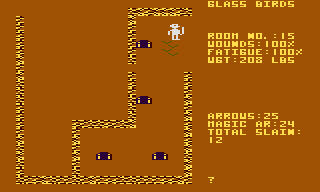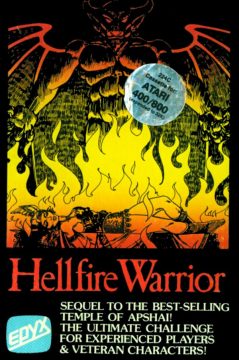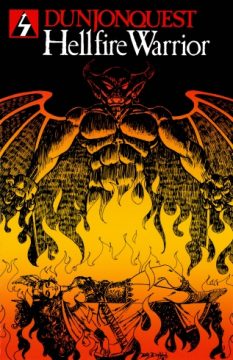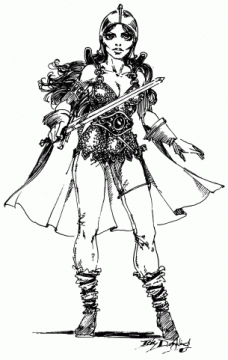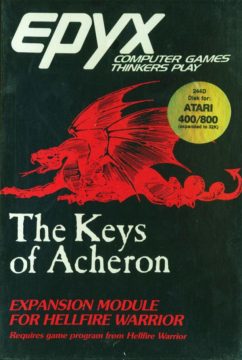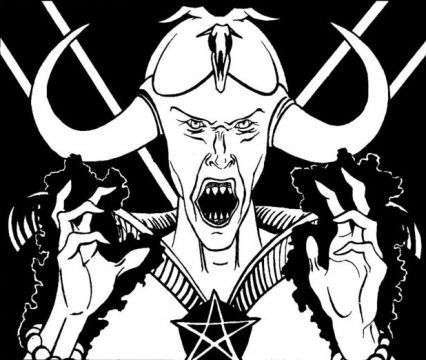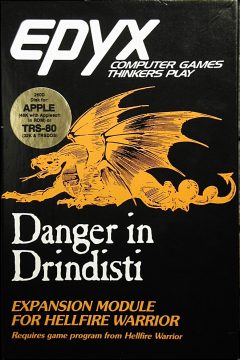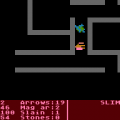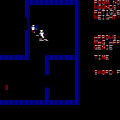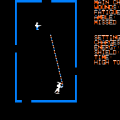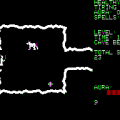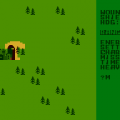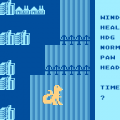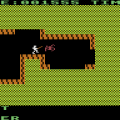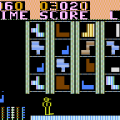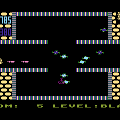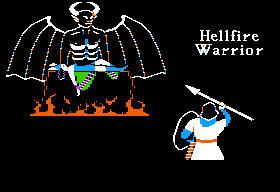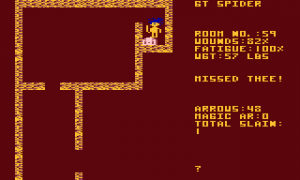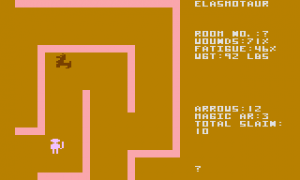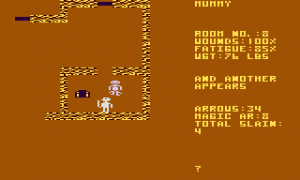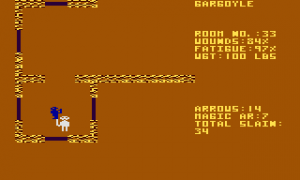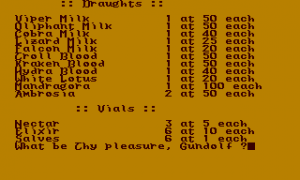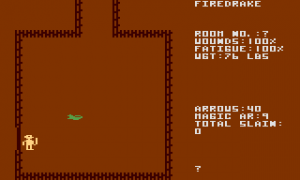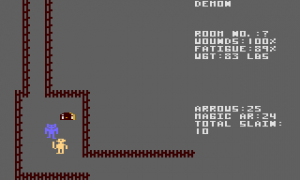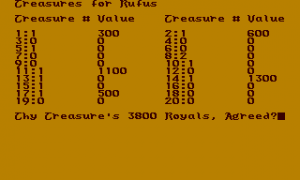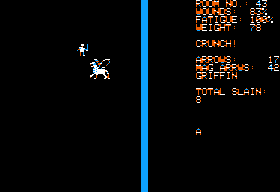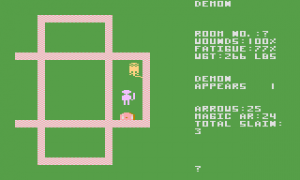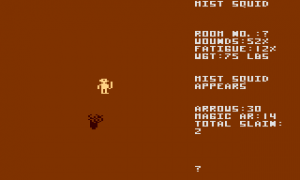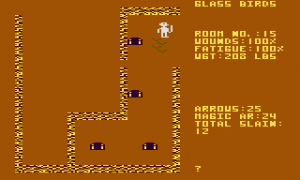After a couple of short filler games and spin-offs, Freeman and Connelley finally delivered a true sequel to their early hit Temple of Apshai. The man called Hammerhand still resides in the small town he freed from the evil influence of the ant god in the previous episode, except it is no longer a small town. The treasures of the Apshaians have lured fortune hunters and cutthroats into the settlement, which not only brought troubles but also provided a major boost for the local economy, leading to significant expansion. Now there is a separate armory, an apothecary and a magic shop. According to the manual, “in addition to a multitude of inns, alehouses, and bordellos”, but you won’t be visiting those in the game.
For Brian Hammerhand has a greater concern than the petty pleasures the town’s new prosperity has to offer. For nights he has been haunted by a strange dream, in which he stumbles upon a sleeping woman inside the darkest and most frightening depths. He picks her up and searches for a way out, but each time he is held back by the personified Death himself, and suddenly wakes up with the mark of is touch on his skin.
His old friend Merlis the magician reveals to him that he dreamt of Brynhild, a warrior queen of days long past, who indeed has been sleeping far beneath the caverns and ruins for centuries, as a punishment for an offense long forgotten. The only thing that can wake her is pure sunlight, and thus Brian heads down into the dunjons again to find and rescue her.
As a direct sequel to Temple of Apshai, Hellfire Warrior assumes players who have mastered the previous game and also bring their high-leveled characters with them. The game goes to great length to explain how the first stage is actually called level 5, not only because it continues after Apshai’s fourth level, but also because it is meant for characters on experience level 5. An ingenius concept, with the sole problem that the game never actually displays a character’s level. Newly created characters, however, begin with a startup boost of 21,000 EXP, so that might serve as a benchmark.
To better prepare oneself for the challenges at hand, players now have access to the three shops mentioned above, with the inn itself merely serving as a hub to them and the dunjons. The weaponry offers the same as the inn did before, with the exception of healing salves, which are now found at the apothecary, besides the stronger elixir and fatigue-reducing nektar. Not enough, the drugstore also offers a variety of special draughts, which give temporary bonus to certain attributes. They are available in limited supply, though, and the manual suggests that taking too much of these drugs may have hidden adverse effects – your character can actually become addicted to substances and suffer from deprivation.
While magic weapons used to be rare goods found only in the deepest corners of the Temple of Apshai, the magician can now finally enchant ordinary weapons and armor, although the higher enchantment factors are obscenely expensive. Magic arrows and other artefacts are also bought here.
Further magical items with obscure effects and even two kinds of special ranged weapons are found in the dunjons, but lacking a proper inventory for those, it’s hard to keep track of the amulets, helmets and rings collected, and even harder to discern the purpose of most. The character import function doesn’t account for them, either, so it’s strongly reccomendable to use the disk save function between sessions (bad luck for owners of the tape version back then). Those treasures, however, are by no means necessary to succeed in the game.
Very different to Apshai, where your objective was just to hoard more and more wealth and experience, the dunjons in Hellfire Warrior actually come with specific objectives, although the game doesn’t check their fulfillment. Just as before, all four dunjon levels are selectable from the beginning, it’s up to the player to restrain oneself to the ones “unlocked” by completing the previous challenge, or not. There’s still no other on-screen reward but the account of treasures, which the game now calculates into money for you. For some reason you have the option to disagree on the calculated value, but it just causes the game to reprompt the question indefinitely.
The first dunjon, level 5, is described as lying directly beneath Apshai‘s 4th one, fittingly called the “Lower Reaches of Apshai”. This (re-)introductory area is meant to give new characters some less dangerous means to gather a small fortune and maybe a few magical items. It is populated by the same kind of insectoid creatures as the first game, and also offers little interesting in terms of dunjon design, except for malicious magic doors that only allow passage in one direction, which can effectively foil the escape plans of the unwary explorer.
Level 6 is very particular for the whole series, because it can really only be beaten in the way the designers intended for it. In contrast to all other dunjons, the entrance immediately locks itself behind you, forcing you to find the only exit. Based on the mythical labyrinth of the Minotaur, the level is full of bull-human hybrids, and of course a confusing labyrinth with tons of dead-ends and same-looking hallways. Therefore, Automated Simulations left out the individual room descriptions for the labyrinth, supposedly to make orientation even harder. This is made up for with the elaborate narrations that come with every treasure in the labyrinth, which in the end are more rich and meaningful as most of the more generic room descriptions in level 5 or 7. After all, a boring hallway is often just a boring hallway, and no flowery eulogy can make them more interesting.
T17 – There is a sizeable hoard in the stegotaur lair (bless their greedy little hearts and grasping large claws), but much of it is junk and some just revolting. Spying a fine pair of boots of amazing lightness, you hastily don them and, even more hurriedly, stuff a few pounds of coins, gauds, and baubles into your pack before departing the area.
Level 7 is “The Vault of the Dead”, in which the key to the deepest ruins (Level 8) is hidden. The enemies here are zombies, mummies and other stock undead, the map is huge and designed to slowly wear you down in your search for the key. This is the original introduction of the dreaded attribute-eating monsters that also appear in the Temple of Apshai expansions (but they are much less of a pain than in Curse of Ra). Other foul obstacles are invisible specres and an abundance of hidden traps.
The last level finally takes you to “The Plains of Hell” to rescue the damsel in her 300-year distress. The demon-infested firepit might disappoint at first glance, since it does appear like it’s all just one huge empty plain. This, however, is all part of a rather tricky and once again very obfuscate puzzle. The manual has as much sense as to give hints encoded in a cypher for this and the Minotaur labyrinth, though. (If only it wasn’t for the huge trouble the engine has with those open, wall-less rooms, same as the first level of Upper Reaches of Apshai) It isn’t enough to just reach the warrior queen, though. You then have to carry her to open daylight in order to wake her up, which with her proud 150 pounds (let’s suppose she’s still wearing her armor) is no easy task. And of course there’s Death waiting for you around the corner …
Hellfire Warrior sports some of the most well-designed maps in the entire series, and its story and theme are astonishingly immersive. Some of the room descriptions feel a bit unmotivated, though, and the writing really shines when it confines itself to show the really important moments of the adventure in Level 6 and 8, namely the many treasures and traps. The difficulty also helps the dunjon raids a great deal and makes for a tension that is missing in Temple of Apshai‘s expansions or the micro quests.
On the other hand, it still is fairly easy to overpower the character. All enemies are fairly slow, and as soon as you get a pair of 7-League Boots you can easily run away from anything. Also, the manual can backbite other RPGs for their “inflated currency” all it wants, the four dunjons hold enough gold and gems to acquire yourself a piece of impenetrable magical armor. Once again it’s mostly a reward for the player that’s sorely missing. Your rescued maid ist no more than a number on the treasure bill (she’s “worth” exactly zero gold pieces).
Nonetheless Hellfire Warrior is the best game in the whole series and a fine dunjon crawl RPG even today, yet it couldn’t wholly repeat the success of Temple of Apshai. While the earlier game practically had the market for itself, Hellfire Warrior went into direct competition with Ultima and Wizardry, who easily banned the game to the third placeamong fantasy RPGs. Unfortunately, the series’ conversion decay had also already set in, so after the obligatory TRS-80, PET and Apple releases, there were no more new ports other than the Atari 400/800. That one, however, is based on the excellent engine version already used in Temple to Apshai, making it once more the definite platform to go for.
The Keys of Acheron – TRS-80, Apple II, Atari 8-bit (1981)
Expansions for Hellfire Warrior were published alongside the Temple of Apshai add-ons. While the engine had experienced several improvements with the newer game, the higher popularity of Apshai probably prevented Automated Simulations from abandoning it altogether, but at least the more obscure Hellfire Warriors was also supported with two sets of maps. The first of these, dubbed Keys of Acheron, was designed by Paul Reiche III, who soon after left the company following Freeman to work with him at Free Fall Associates. Even later he became famous for creating the first two Star Control games.
The story is plain and simple: Summoned by the mighty wizard Abosandrus, you have to travel to different dimensions in order to recover four magical gems, the Keys of Acheron. Only their power can put a stop to the evildoing of the demon lord Kronus, who plans to invade the Earth and of course isn’t exactly enthusiastic about the plan. The search for the keys leads you to the lair of a dragon, a temple within a prehistoric jungle (complete with dinosaurs), the inside of a dead volcano and finally the realm of Kronus himself.
For a long time, no working combination of Hellfire Warrior and Keys of Acheron was preserved from any platform. More recently both the the Apple II and Atari versions have become available, finally making it possible again to experience this episode.
Danger in Drindisti – TRS-80, Apple II, Atari 8-bit (1982)
The last release to ever bear the DunjonQuest label anywhere on the box, Danger in Drindisti plays along with the structure of four independent sub-quests for one greater goal that was introduced in Keys of Acheron. The land is terrorized by Bandits, Dragons and worse. As the greatest warrior of Drindisti you’re called in by the wizard king Yoturni, who suspects one of his four arch enemies to be behind all the trouble. He doesn’t know which one, but he just sends you out to kill them all. Can’t be sure enough.
The dunjons in this second expansion are numbered 6 through 9, but since it was hard-coded into the Hellfire Warrior-engine not to display any room numbers in level 6 and 8, the recommended order of play is actually 7-6-9-8, corresponding to their difficulty.
The level numbering isn’t the only confusing thing in Danger in Drindisti, though. The first dunjon (No. 7) starts out with a deceptive glass labyrinth, where walls seemingly appear out of nowhere at any given time. It also includes an incredibly cryptic puzzle involving fragile glass statues. That, however, is nothing compared to “The Abode of the Illusionist”, an impossible maze that makes no sense, with space bending itself and hallways that lead into endless loops.
Level 9 (which means the third one. Confused yet?) is the only normal dunjon in the game, a huge temple and hideout to the high priest of a cult of demon worshippers. “Normal” shouldn’t be taken for the misguided conclusion that it won’t send you running around clueless in search for the inner chambers. Level 8 finally is basically the same as the illusionists’ hideout, only it throws you into a huge nothingness, with no walls or other landmarks whatsoever. The only way to solve it is to run around aimlessly for hours in hope to stumble upon a mysterious sage (represented as a treasure chest, as the engine doesn’t support any friendly NPCs in the dunjons) by chance, who shows the way to the altar of the demigod, the last target in this impossible hit job.
While Hellfire Warrior knew that its puzzles were damn cryptic and provided hints for the more aggravating sections in the manual, Dangers in Drindisti just throws you in at the deep end, and that means much, much deeper compared to the main game. Most dunjon designs are just lazy in their reliance on one unfair gimmick, which makes Drindisti not only frustrating, but also really boring (with the exception of the demon worshipper’s temple). If the solutions to Ultima II and Simon’s Quest were too obvious and logical for you, this might be the game/expansion for you.
